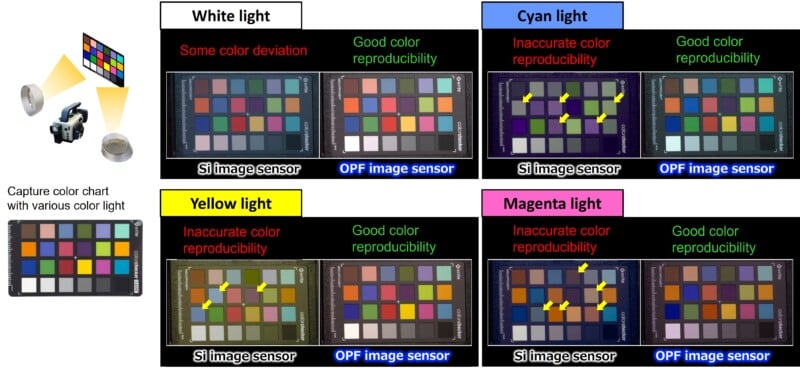Panasonic Still Hasn’t Finished the Organic CMOS Sensor it Began in 2013
![]()
Panasonic has touted additional benefits of the organic CMOS sensor that it has been working on for nearly a decade, and while the developments still sound enticing, the company seems no closer to release.
On Friday, Panasonic wrote a lengthy blog post where it noted the benefits of its organic CMOS sensor with regard to its “excellent color reproduction” under multiple types of light sources.
“In this technology, the organic thin film that performs photoelectric conversion and the circuit that stores and reads out electric charge are completely independent of each other,” Panasonic writes.
“This unique layered structure reduces the sensitivity of each pixel in green, red, and blue in wavelength regions outside the target range. Since it can achieve spectral characteristics with low color mixing, accurate color reproduction is possible regardless of the type of light source.”
DPReview‘s Richard Butler explains that the sensor appears to have reduced crosstalk, which basically means that the red, green, and blue pixels of the sensor collect only their intended color and that light — regardless of type and color cast — won’t spill across each pixel and therefore muddy color reproduction.

That sounds fantastic, but so does every other promise Panasonic has made about the organic CMOS sensor it has released over the course of the last decade. Panasonic’s direct involvement with the organic CMOS sensor stems back to June of 2013 when it partnered up with Fujifilm and it has yet to materialize.
Last year, the company grabbed headlines with the promise the technology would result in an 8K sensor, achieving high resolution, high dynamic range, relatively high framerate, and a global shutter. Basically, it would be a game-changing tech.
Those highfalutin claims were announced at the end of 2021 and this sensor has still yet to appear. Now Panasonic’s reduced crosstalk blog post doesn’t even focus on photography or videography as the core, but rather how this sensor will have “a wide range of applications.” Basically, Panasonic is trying to hype this decade-old project as even more valuable to more people. That would be great if the last 10 years had resulted in something tangible, but they have not.
Back in 2021, Panasonic did not give the sense that this sensor was close to launch and after this most recent blog post, that hasn’t changed.
Image credits: Header photo by Monoist.